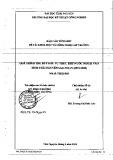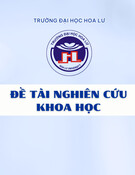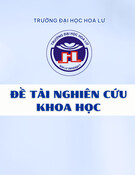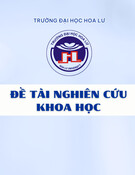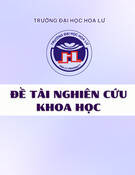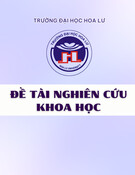
RESEARC H Open Access
The HPB-AML-I cell line possesses the properties
of mesenchymal stem cells
Bambang Ardianto
1,2*
, Takeshi Sugimoto
2
, Seiji Kawano
2*
, Shimpei Kasagi
2
, Siti NA Jauharoh
2
, Chiyo Kurimoto
2
,
Eiji Tatsumi
3
, Keiko Morikawa
3
, Shunichi Kumagai
2
, Yoshitake Hayashi
1
Abstract
Background: In spite of its establishment from the peripheral blood of a case with acute myeloid leukemia (AML)-
M1, HPB-AML-I shows plastic adherence with spindle-like morphology. In addition, lipid droplets can be induced in
HPB-AML-I cells by methylisobutylxanthine, hydrocortisone, and indomethacin. These findings suggest that HPB-
AML-I is similar to mesenchymal stem cells (MSCs) or mesenchymal stromal cells rather than to hematopoietic cells.
Methods: To examine this possibility, we characterized HPB-AML-I by performing cytochemical, cytogenetic, and
phenotypic analyses, induction of differentiation toward mesenchymal lineage cells, and mixed lymphocyte culture
analysis.
Results: HPB-AML-I proved to be negative for myeloperoxidase, while surface antigen analysis disclosed that it was
positive for MSC-related antigens, such as CD29, CD44, CD55, CD59, and CD73, but not for CD14, CD19, CD34,
CD45, CD90, CD105, CD117, and HLA-DR. Karyotypic analysis showed the presence of complicated abnormalities,
but no reciprocal translocations typically detected in AML cases. Following the induction of differentiation toward
adipocytes, chondrocytes, and osteocytes, HPB-AML-I cells showed, in conjunction with extracellular matrix
formation, lipid accumulation, proteoglycan synthesis, and alkaline phosphatase expression. Mixed lymphocyte
culture demonstrated that CD3
+
T-cell proliferation was suppressed in the presence of HPB-AML-I cells.
Conclusions: We conclude that HPB-AML-I cells appear to be unique neoplastic cells, which may be derived from
MSCs, but are not hematopoietic progenitor cells.
Background
Mesenchymal stem cells (MSCs) constitute a cell popula-
tion, which features self-renewal and differentiation into
adipocytes, chondrocytes, and osteocytes. Human MSCs
have been isolated from various tissues and organs, such
as muscle, cartilage, synovium, dental pulp, bone marrow,
tonsils, adipose tissues, placenta, umbilical cord, and thy-
mus (reviewed by [1]). The biological roles of MSCs were
initially described by Friedenstein and colleagues in
1970s. They observed bone formation and reconstitution
of the hematopoietic microenvironment in rodents with
subcutaneously transplanted MSCs (reviewed by [2]). In
addition to providing support for the early stage of hema-
topoiesis, MSCs have also been reported to suppress the
proliferation of CD3
+
T-cells [3], which led to the utiliza-
tion of MSCs in the management of various pathologic
conditions, such as graft-versus-host disease (GvHD)
after allogeneic bone marrow transplantation (reviewed
by [4-6]). Recent studies have successfully isolated can-
cer-initiating cells with properties similar to those of
MSCs from cases with some neoplasms, such as osteosar-
coma [7], Ewing’s sarcoma [8], and chondrosarcoma [9].
Furthermore, the characteristics of MSCs isolated from
cases with hematopoietic neoplasms have also been
investigated. Shalapour et al. [10] and Menendez et al.
[11] identified the presence of oncogenic fusion tran-
scripts, such as TEL-AML1,E2A-PBX1,andMLL rear-
rangements, in MSCs isolated from cases with B-lineage
acute lymphoblastic leukemia (B-ALL). These reports
suggested that some leukemias may be derived from the
* Correspondence: bambang.ardianto@gmail.com; sjkawano@med.kobe-u.ac.jp
1
Division of Molecular Medicine and Medical Genetics, Department of
Pathology, Graduate School of Medicine, Kobe University, Kobe, Japan
2
Department of Clinical Pathology and Immunology, Graduate School of
Medicine, Kobe University, Chuo-Ku, Kobe 650-0017, Japan
Full list of author information is available at the end of the article
Ardianto et al.Journal of Experimental & Clinical Cancer Research 2010, 29:163
http://www.jeccr.com/content/29/1/163
© 2010 Ardianto et al; licensee BioMed Central Ltd. This is an Open Access article distributed under the terms of the Creative
Commons Attribution License (http://creativecommons.org/licenses/by/2.0), which permits unrestricted use, distribution, and
reproduction in any medium, provided the original work is properly cited.

common precursors of both MSCs and hematopoietic
stem cells (HSCs).
HPB-AML-I has been considered a unique cell line. In
spite of its establishment from the peripheral blood
mononuclear cells (PBMCs) of a case with acute mye-
loid leukemia (AML)-M1, this cell line reportedly has
the features of spindle-like morphology and plastic
adherence [12]. The detached HPB-AML-I cells were
surprisingly capable of proliferating and adhering to
plastic surfaces after passage. Immunophenotypic analy-
sis of HPB-AML-I demonstrated the absence of hemato-
poietic cell-surface antigens and showed that this cell
line resembles marrow stromal cells [12]. Moreover, in
the presence of methylisobutylxanthine, hydrocortisone,
and indomethacin, but not troglitazone, an increase in
the number of lipid droplets was observed in these cells
[12]. In view of these features, we further investigated
the possibility of HPB-AML-I being a neoplasm of MSC
origin.
Recently, some human MSC lines have been estab-
lished from the bone marrow [13,14] and umbilical cord
blood [15] cells of healthy donors. To establish a stable
cell line, genes encoding the human telomerase reverse
transcriptase (hTERT), bmi-1, E6, and E7 proteins were
transduced to prolong the life span of the healthy
donor-originated MSCs [13-15]. However, there have
been no reports of the establishment of MSC lines from
human bone marrow cells without in vitro gene trans-
duction. Since a number of the characteristics of HPB-
AML-I are not typically observed in leukemic cells, we
wondered whether HPB-AML-I cells are neoplastic cells
originating from the non-hematopoietic compartments
of bone marrow, such as MSCs.
Methods
Cell lines and cell culture
HPB-AML-I cells were kindly provided by Dr. K. Mori-
kawa (Sagami Women’s University, Sagamihara, Japan)
and 5 × 10
5
of these cells were cultured in 10 ml of
RPMI-1640 medium supplemented with L-glutamine
(Gibco, Carlsbad, CA), 10% fetal bovine serum (FBS)
(Clontech, Mountain View, CA), 50 U/ml of penicillin
(Lonza, Walkersville, MD), and 50 μg/ml of streptomy-
cin (Lonza). Cell culture was performed in a T-25 flask
and was maintained in a 37°C incubator humidified with
5% CO
2
. Cell passage was performed twice a week.
UCBTERT-21, the hTERT-transduced umbilical cord
blood mesenchymal stem cell (MSC) line [15], was
obtained from the Japanese Collection of Research Bior-
esources (JCRB, Osaka, Japan) and propagated in a T-75
flask in a total number of 1.5 × 10
5
cells. Cell culture
was maintained in 15 ml of Plusoid-M medium (Med
Shirotori, Tokyo, Japan) containing 5 μg/ml of gentami-
cin (Gibco). The culture medium was replaced twice a
week and cell passage was performed when the cultured
cells reached 80-90% of confluence.
Cytochemical analysis
The following cytochemical staining was performed
according to the manufacturer’s instructions: May Grün-
wald-Giemsa (Sysmex, Kobe, Japan), myeloperoxidase-
Giemsa, toluidine blue, alkaline phosphatase-Safranin O
(Muto, Tokyo, Japan), Sudan Black B-hematoxylin, oil
red O-hematoxylin (Sigma-Aldrich, St. Louis, MO), and
von Kossa-nuclear fast red (Diagnostic BioSystems, Plea-
santon, CA).
Cytogenetic analysis
Cytogenetic analysis was performed according to the
standard protocols. The karyotype was determined by
G-banding using trypsin and Giemsa (GTG) [16] to
examine 50 cells. The best metaphase was then photo-
graphed to determine the karyotype. The specimen was
also submitted to spectral karyotyping (SKY)-fluores-
cence in situ hybridization (FISH) assay according to
Ried’s method using whole chromosome painting
(WCP) libraries (cytocell for WCP) and a-satellite DNA
probes [17].
Cell-surface antigen analysis
Flow cytometric analysis was performed by using the fol-
lowing monoclonal antibodies recommended by the
International Society for Cellular Therapy (ISCT)
(reviewed by [2]) and monoclonal antibodies used in the
study of Wang et al. [18]: MP9 (CD14), SJ25C1 (CD19),
MAR4 (CD29), 8G12 (CD34), 515 (CD44), 2D1 (CD45),
IA10 (CD55), p282 (CD59), AD2 (CD73), 5E10 (CD90),
SN6 (CD105), 104D2 (CD117), and L243 (HLA-DR). All
of these monoclonal antibodies were obtained from BD
Biosciences (San Jose, CA), except for SN6 from Invitro-
gen (Carlsbad, CA). Cells were resuspended in a total
number of 2 × 10
5
in 50 μl of phosphate-buffered saline
(PBS) supplemented with 4% FBS, then incubated with
20 μl of monoclonal antibodies, except for 5E10 (2 μl)
and SN6 (5 μl),for45minat4°C,andtheconjugated
cells fixed with 1 ml of 4% paraformaldehyde solution
(Wako, Osaka, Japan). Flow cytometric analysis was per-
formed with Cell Quest software and the FACSCalibur
device (BD Biosciences) to examine 20,000 events.
In vitro differentiation toward adipocytes, chondrocytes,
and osteocytes
To induce adipogenesis and osteogenesis, 1 × 10
3
cells
were cultured in 500 μl of medium in a four-well cham-
ber slide. Three days after propagation, the culture med-
ium was replaced with 500 μl of StemPro adipogenesis
or osteogenesis differentiation medium (Gibco) contain-
ing 5 μg/ml of gentamicin. Chondrogenesis was induced
Ardianto et al.Journal of Experimental & Clinical Cancer Research 2010, 29:163
http://www.jeccr.com/content/29/1/163
Page 2 of 9

with a micromass culture system [19,20], in which 5 ×
10
2
of the cells were resuspended in 10 μlofculture
medium and applied to the center of a culture well. A
96-well culture plate was used in our study. Two hours
after propagation, 100 μl of StemPro chondrogenesis dif-
ferentiation medium containing 5 μg/ml of gentamicin
was added. The differentiation medium was replaced
twice a week.
Mixed lymphocyte culture assay
PBMCs were separated from the heparinized peripheral
blood of a healthy donor by means of Ficoll-Paque den-
sity gradient centrifugation (Amersham Biosciences,
Uppsala, Sweden). CD3
+
T-cells were purified from
PBMCs by magnetic-activated cell sorting (MACS) posi-
tive selection (Miltenyi Biotec, Auburn, CA) and 1 × 10
6
of these cells were cultured for 48 h in a 96-well culture
plate in the presence of 12.5 μg/ml of phytohemaggluti-
nin (Wako) with or without irradiated (25 Gy) HPB-
AML-I and UCBTERT-21 (0, 1 × 10
3
,1×10
4
,and1×
10
5
cells/well) cells. From each culture well, 100 μlof
cell suspension was pulsed with 10 μlofCellCounting
Kit-8 solution (Dojindo, Tokyo, Japan) at 37°C for 4 h.
The optical density at 450 nm was measured to deter-
mine cell viability in each of the culture wells.
Results
HPB-AML-I shows plastic adherence, negative
myeloperoxidase expression, and complex chromosomal
abnormalities
Inverted microscopic examination (Figure 1A) and
May Grünwald-Giemsa staining (Figure 1B) of HPB-
AML-I cells revealed that this cell line is composed of
round-polygonal and spindle-like cells. Unlike the
round-polygonal cells, HPB-AML-I cells with the spin-
dle-like morphology attached to plastic surfaces. Since
HPB-AML-I was established from a case with AML,
we examined this cell line for the presence of myelo-
peroxidase expression. The human acute promyelocytic
leukemia (APL) NB4 cell line was used as positive con-
trol in this examination (Figure 1C). We found that
HPB-AML-I was negative for myeloperoxidase expres-
sion (Figure 1D).
HPB-AML-I was also subjected to cytogenetic analysis,
which demonstrated the presence of a complex karyo-
type with a modal chromosome number of 64 (range:
57-65; Figure 2A). A single X chromosome and a num-
ber of other abnormalities, mainly consisting of chromo-
some gains, chromosome losses, translocations, and
deletions, were detected by SKY-FISH assay (Figure 2B).
There were no reciprocal chromosomal translocations,
which are frequently observed in AML cases.
HPB-AML-I expresses cell-surface antigens characteristic
for MSCs
HPB-AML-I was examined by means of flow cytometric
analysis for cell-surface antigens, which are widely used
to identify the presence of MSCs. HPB-AML-I expressed
CD29, CD44, CD55, CD59, and CD73, but no cell-sur-
face expression of CD14, CD19, CD34, CD90, CD105,
CD117, or HLA-DR was detected (Figure 3A). The cell-
surface antigen expression patterns of UCBTERT-21
[15] and F6 [21] cell lines and human MSCs isolated
from aorta-gonad-mesonephros, yolk sac [18], bone
marrow [22], and umbilical cord blood [23] are pre-
sented in Table 1 for comparison, showing that there
are phenotypic similarities between HPB-AML-I and
UCBTERT-21, which was established from human
umbilical cord blood and transduced with hTERT.
Flow cytometric analysis showed that 11.9% of HPB-
AML-I cells expressed CD45 (Figure 3A). We postulated
that the presence of two morphological phases of HPB-
AML-I cell line may be related to CD45 expression. For
addressing this hypothesis, we performed a prolonged
cell culture to increase the confluence, resulting in a
morphological change of spindle-like HPB-AML-I cells
toward round-polygonal. The round-polygonal cells,
A
NB4 HPB
-
AML
-
I
C D
B
Figure 1 Morphological and cytochemical characteristics of
HPB-AML-I. Inverted microscopic examination (A) and May
Grünwald-Giemsa staining (B) revealed that HPB-AML-I features a
round-polygonal (arrow) and spindle-like (arrowhead) morphology.
The human acute promyelocytic leukemia (APL) NB4 cell line was
used as positive control for myeloperoxidase staining. Positive
reactions are indicated with an arrow (C). Absence of
myeloperoxidase expression was observed in the cytospin-prepared
HPB-AML-I cells (D). Original magnification ×400.
Ardianto et al.Journal of Experimental & Clinical Cancer Research 2010, 29:163
http://www.jeccr.com/content/29/1/163
Page 3 of 9

which were harvested from a confluent culture with
gently washing, but no trypsinization, were positive for
CD45 in 25.7% of cells (Figure 3B). Interestingly, the
CD45 expression returned to low positivity (10.1%) after
the round-polygonal cells were cultivated for another
three days, when they became adherent and spindle-like
(Figure 3B).
HPB-AML-I cells are capable of acquiring the properties of
adipocytes, chondrocytes, and osteocytes
To investigate the multipotency of HPB-AML-I cells, we
induced them to differentiate toward adipocytes, chon-
drocytes, and osteocytes. For comparison, the results of
examination of undifferentiated HPB-AML-I cells with
an inverted microscope are also shown (Figure 4A).
Two weeks after the induction of adipogenesis, morpho-
logical changes were observed in HPB-AML-I cells. The
differentiated cells retained the spindle-like morphology
or appeared as large polygonal cells. In addition, cyto-
plasmic vacuoles of various sizes were observed and
inverted microscopic examination showed that these
vacuoles occurred in solitary or aggregated formations
(Figure 4B). While Sudan Black B and oil red O did not
stain the cytoplasm of undifferentiated cells (Figure 4C
and 4E), the cytoplasmic vacuoles of differentiated HPB-
AML-I cells were positive for these cytochemical stain-
ing (Figure 4D and 4F), suggesting the presence of lipid
accumulation in the adipogenic-differentiated HPB-
AML-I cells.
Two weeks after the induction of chondrogenesis,
the differentiated HPB-AML-I cells showed polygonal
morphology, which made them distinct from the undif-
ferentiated cells. Inverted microscopic examination
demonstrated the presence of a number of vacuoles
in the cytoplasm of differentiated HPB-AML-I
cells (Figure 4G). In contrast to the undifferentiated
cells (Figure 4H), the differentiated HPB-AML-I cells
formed lacunae. The proteoglycan-rich extracellular
matrix, as indicated by positive toluidine blue staining,
surrounded the lacunae (Figure 4I). The presence of
lacunae, as well as extracellular proteoglycan accumu-
lation, suggested that the micromass of chondrogenic-
differentiated HPB-AML-I cells acquires the properties
of a cartilage.
Inverted microscopic examination three weeks after the
induction of osteogenesis demonstrated the presence of a
number of cell processes and an eccentrically located
nucleus in the differentiated HPB-AML-I cells (Figure
4J). The undifferentiated cells did not express alkaline
phosphatase as shown by negative cytochemical staining
for this protein (Figure 4K). On the other hand, cyto-
chemical staining resulted in positive staining for alkaline
phosphatase in the cytoplasm of differentiated HPB-
AML-I cells (Figure 4L). Moreover, the differentiated
Chromosome numbers 57 58 59 60 61 62 63 64 65 Total
Cell numbers 1 1 2 3 7 4 9 14 9 50
A
B
Figure 2 Cytogenetic features of HPB-AML-I. Karyotypic analysis performed on 50 HPB-AML-I cells demonstrated that each of these cells had
abnormal chromosome numbers ranging from 57 to 65 (modal: 64) (A). Reverse DAP (left side) and SKY-FISH (right side) of a representative
HPB-AML-I cell with a total number of 64 chromosomes are shown. The complete karyotype has been reported as: 61-65 <3n>, X, -X, -Y, der(X) t
(X;2)(p22.1;?), der(1;18)(q10;q10), der(1;22)(q10;q10), der(2) (2pter®2q11.2::2?::1p21®1pter), +der(3) t(3;14)(p13;q?), der(4) t(4;8)(q11;q11.2), der(5) t
(5;18)(p13;p11.2), i(5)(p10), -6, +der(7) t(3;7)(?;q11.2), +der(7) t(7;19)(q22;q13.1), -8, der(8) del(8)(p?) del(8)(q?), der(8) (qter®q22::p23®qter), -9, +10,
der(10;20)(q10;q10)x2, der(11) t(1;11)(?;q13), der(12) t(12;19)(p13;q13.1), +der(12) (5qter®5q13::12?::cen::12?::1?), +der(12) (5qter®5q13::12?::
cen::12?::1?::3?), -13, der(13) (13qter®13p11.2::11?::13?::11?), der(13) (13qter®13p11.2::11?::20?::11?::22?), -14, der(14) (14pter®14q24::3?::1?), der(15)
(15?::p11.2®q13::q15®qter), der(15) (15qter®15p11.2::7?::X?), -16, der(17) t(1;17)(p13;p11.2), der(17) t(9;17)(?;p11.2), der(18) t(18;?)(q11.2;?), -19, der
(19) t(5;19)(?;q11), +20, +20, +der(20) t(17;20)(?;p11.2), -21, -22, -22, +der(?) t(?;12)(q;15) (B).
Ardianto et al.Journal of Experimental & Clinical Cancer Research 2010, 29:163
http://www.jeccr.com/content/29/1/163
Page 4 of 9

HPB-AML-I cells also secreted calcium, which constitu-
tes the extracellular matrix of the bone, as shown by
von Kossa staining (Figure 4M and 4N). These two find-
ings suggested the acquisition of osteogenic characteris-
tics by HPB-AML-I cells following the induction of
osteogenesis.
Inhibition of CD3
+
T-cell proliferation in the presence of
HPB-AML-I cells
CD3
+
T-cells obtained from peripheral blood were cul-
tured with or without HPB-AML-I cells. The XTT
absorbance levels at 450 nm, which show the viability of
CD3
+
T-cells, decreased in a dose-dependent manner
CD14 CD19 CD29 CD34
CD44 CD45 CD55 CD59
CD73 CD90 CD105 CD117
HLA-DR
Events
A
CD45
Round-polygonal cells
CD45
Three days after propagatio
n
B
Figure 3 Phenotypic profiles of HPB-AML-I. The expression of MSC-related antigens in the HPB-AML-I cell line is shown (A). CD45 expression
of round-polygonal HPB-AML-I cells (upper) and of the cells, which were cultivated for three days after propagation of round-polygonal HPB-
AML-I cells (lower), are shown (B). Flow cytometric results for the antigens indicated are shown in black. IgG isotype (not shaded) was used as
negative control.
Table 1 Cell-surface antigen expression in HPB-AML-I and other MSCs
Antigens HPB-AML-I UCBTERT-21 [15] F6 [21] ISCT criteria [2] Wang et al. [18] Lee et al. [22] Majore et al. [23]
CD14 - - - - - - ND
CD19 - ND ND - - ND ND
CD29 + + + ND + ND ND
CD34 - - - - - ND ND
CD44 + + + ND + + +
CD45 - - - - - ND ND
CD55 + + ND ND ND ND ND
CD59 + + ND ND ND ND ND
CD73 + ND ND + + ND +
CD90 - - ND + ND + +
CD105 - ND ND + + + +
CD117 - - ND ND ND ND ND
HLA-DR - ND - - - ND ND
ND: not determined
Ardianto et al.Journal of Experimental & Clinical Cancer Research 2010, 29:163
http://www.jeccr.com/content/29/1/163
Page 5 of 9



![Báo cáo seminar chuyên ngành Công nghệ hóa học và thực phẩm [Mới nhất]](https://cdn.tailieu.vn/images/document/thumbnail/2025/20250711/hienkelvinzoi@gmail.com/135x160/47051752458701.jpg)



